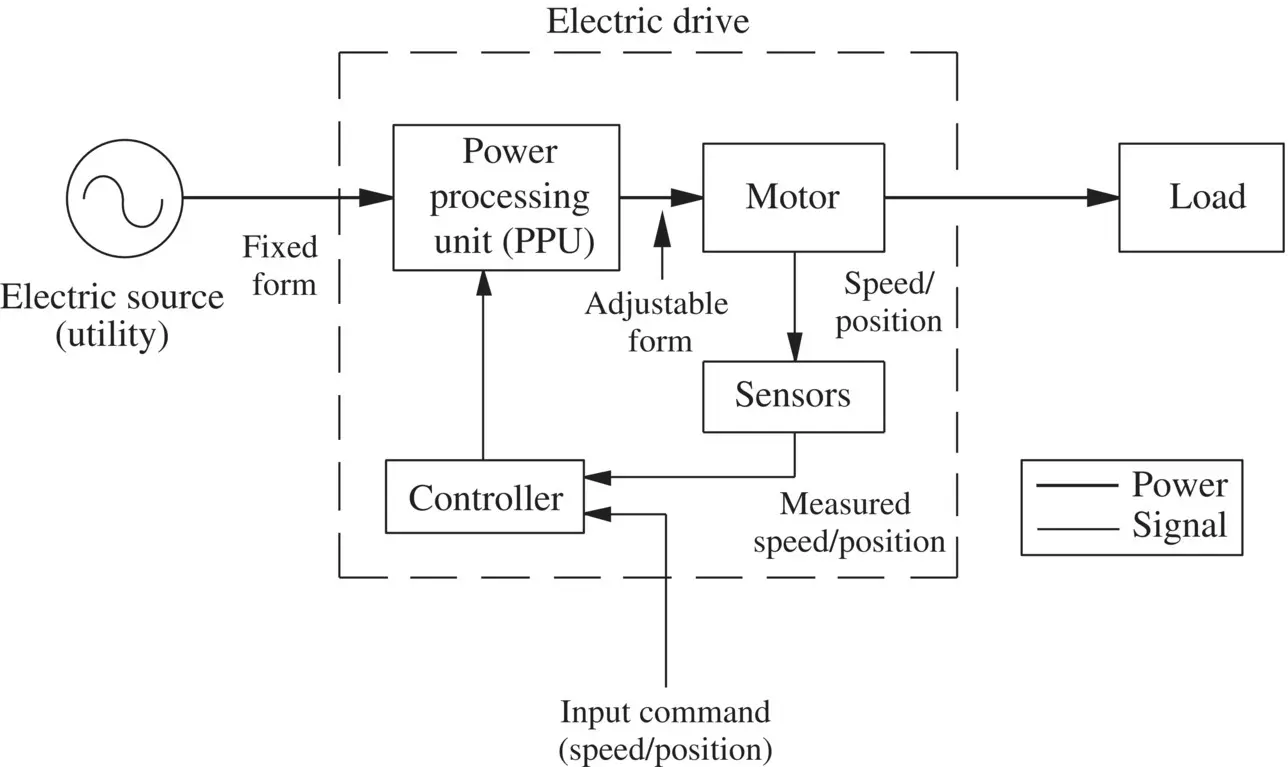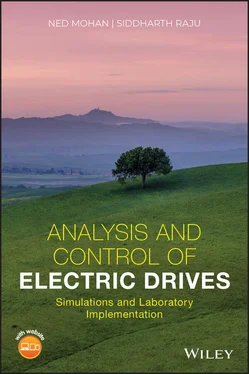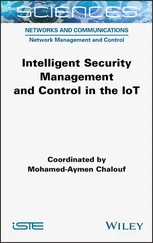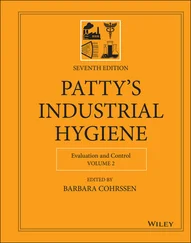1 ...6 7 8 10 11 12 ...16 1 Part I: Fundamental Concepts Chapter 2deals with the modeling of mechanical systems coupled to electric drives, as well as how to determine drive specifications for various types of loads. Chapter 3describes magnetic concepts and the laws governing electromechanical energy conversion. An introduction to PPUs is presented in Chapter 4. Chapter 5explains the design of feedback control in vector control of ac drives. As a background to the discussion of ac motor drives, the rotating fields in ac machines are described in Chapter 6utilizing space vectors. In controlling PPUs, the role of space vector PWM is described in Chapter 7.
2 Part II: Steady‐State AnalysisUsing the space vector theory, the sinusoidal PMAC motor drives are discussed in Chapter 8. Chapter 9analyzes induction motors and focuses on their basic principles of operation in a steady state. A concise but comprehensive discussion of controlling speed with induction‐motor drives is provided in Chapter 10.
3 Part III: Dynamic Analysis Chapters 11and 12lay down the foundation on dq‐based analysis of ac machines and drives. Chapter 13describes the vector‐control of induction motors. Chapter 14is on encoder‐less vector control of induction motor drives. Chapter 15is on doubly fed generators used in wind generators. Direct‐torque control is explained in Chapter 16. The vector control is applied to the surface permanent, and the interior permanent‐magnet motor drives in Chapter 17. The reluctance drives, including stepper‐motors and switched‐reluctance drives, are explained in Chapter 18.
1 1. What is an electric drive? Draw the block diagram and explain the roles of its various components.
2 2. What has been the traditional approach to controlling the flow rate in the process industry? What are the major disadvantages which can be overcome by using ASDs?
3 3. What are the factors responsible for the growth of the adjustable‐speed drive market?
4 4. How does an air conditioner work?
5 5. How does a heat pump work?
6 6. How do ASDs save energy in air conditioning and heat pump systems?
7 7. What is the role of ASDs in industrial systems?
8 8. There are proposals to store energy in flywheels for load leveling in utility systems. During the off‐peak period for energy demand at night, these flywheels are charged to high speeds. At peak periods during the day, this energy is supplied back to the utility. How would ASDs play a role in this scheme?
9 9. What is the role of electric drives in electric transportation systems of various types?
10 10. What are the different disciplines that make up the study and design of electric‐drive systems?
1 1. https://eere‐exchange.energy.gov/FileContent.aspx?FileID=3b30e33e‐9f3e‐442b‐b623‐d724924b8581
2 2. https://www.eia.gov/tools/glossary/index.php?id=Primary%20energy
3 3. https://www.eia.gov/tools/faqs/faq.php?id=427&t=3
4 4. https://www.energy.gov/sites/prod/files/2014/02/f8/Motor%20Energy%20Savings%20Potential%20Report%202013‐12‐4.pdf
5 5. https://sciamble.com
6 6. Clark, K., Miller, N. W., and Sanchez‐Gasca, J. J. (2009). Modeling of GE wind turbine‐generators for grid studies. GE Energy Report, Version 4.4, 9 September 2009.
7 7. Johnson, K. E. (2004). Adaptive torque control of variable speed wind turbines. NREL Technical Report, August 2004.
1 Mohan, N. (1981). Techniques for energy conservation in AC motor driven systems. Electric Power Research Institute Final Report EM‐2037, Project 1201‐1213, September 1981.
2 Mohan, N. and Ramsey, J. (1986). Comparative study of adjustable‐speed drives for heat pumps. Electric Power Research Institute Final Report EM‐4704, Project 2033‐4, August 1986.
1 1‐1. A US Department of Energy report estimates that over 100 billion kWh/year can be saved in the United States by various energy conservation techniques applied to the pump‐driven systems. Calculate (a) how many 1000‐MW generating plants running constantly supply this wasted energy and (b) the annual savings in dollars if the cost of electricity is 0.10$/kWh.
2 1‐2. Visit your local machine‐tool shop and make a list of various electric drive types, applications, and speed/torque ranges.
3 1‐3. Repeat Problem 1-2 for automobiles.
4 1‐4. Repeat Problem 1-2 for household appliances.
5 1‐5. In wind turbines, the ratio (Pshaft/Pwind) of the power available at the shaft to the power in the wind is called the coefficient of performance, Cp, which is a unit‐less quantity. For informational purpose, the plot of this coefficient, as a function of λ, is shown in Fig. P1-5[6] for various values of the blades pitch‐angle θ, where λ is a constant times the ratio of the blade‐tip speed and the wind speed.The rated power is produced at the wind speed of 12 m/s where the rotational speed of the blades is 20 rpm. The cut‐in wind speed is 4 m/s. Calculate the range over which the blade speed should be varied, between the cut‐in and the rated wind speeds, to harness the maximum power from the wind. In this range of wind speeds, the blade’s pitch‐angle θ is kept at nearly zero. Note: this simple problem shows the benefit of varying the speed of wind turbines, by means of a variable‐speed drive, for maximizing the harnessed energy. Fig. P1-5 Plot of Cp as a function of λ [6].
6 1‐6. Read the report in Appendix 1‐A in the accompanying website “Adaptive Torque Control of Variable Speed Wind Turbines” by Kathryn E. Johnson, National Renewable Energy Laboratory [7].
7 1‐7. In wind turbines, describe the Standard Region 2 Control and describe how it works in your own words.
8 1‐8. Read the report in Appendix 1‐B in the accompanying website “Final Report on Assessment of Motor Technologies for Traction Drives of Hybrid and Electric Vehicles” and answer the following questions for HEV/EV applications:What are the types of machines considered?What type of motor is the most popular choice?What are the alternatives if NdFeB magnets are not available?What are the advantages and disadvantages of SR motors?
9 1‐9. Read the report in Appendix 1‐C in the accompanying website “Evaluation of the 2010 Toyota Prius Hybrid Synergy Drive System” and answer the following questions:What are ECVT, P, CU, and ICE?What type of motor is used in this application?
10 1‐10. Read the report in Appendix 1‐D and summarize the possibility of using SR motors in HEV/EV applications.
1 (Adapted from chapter 1 of Electric Machines and Drives: A First Course ISBN: 978‐1‐118‐07481‐7 by Ned Mohan, January 2012 and from chapter 1 of Advanced Electric Drives: Analysis, Control, and Modeling Using MATLAB/Simulink ISBN: 978‐1‐118‐48548‐4 by Ned Mohan, August 2014)
2
Understanding Mechanical System Requirements for Electric Drives
2‐1 INTRODUCTION
Electric drives are an interface between an electrical system and a mechanical system, as Fig. 2-1shows. They themselves consist of an electric machine and a power electronic converter. In subsequent chapters of this book, we will look at the power electronic converter and its role, as well as analyze electric machines and how they can be controlled, given the desired speed and position of the mechanical system.

Fig. 2-1 Block diagram of adjustable speed drives.
Читать дальше













